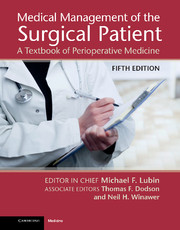Book contents
- Frontmatter
- Dedication
- Contents
- List of Contributors
- Preface
- Introduction
- Part 1 Perioperative Care of the Surgical Patient
- Section 1 General
- Section 2 Cardiology
- Section 3 Hypertension
- Section 4 Pulmonary
- Section 5 Gastroenterology
- Section 6 Hematology
- Section 7 Infectious disease
- Section 8 Renal disease
- Section 9 Endocrinology
- Section 10 Rheumatology
- Section 11 Neurology
- Section 12 Surgery in the Elderly
- Section 13 Obesity
- Chapter 41 Perioperative medical management of obese patients
- Section 14 Transplantation
- Section 15 Psychiatric Disorders
- Section 16 Peripartum Patients
- Part 2 Surgical Procedures and their Complications
- Index
- References
Chapter 41 - Perioperative medical management of obese patients
from Section 13 - Obesity
Published online by Cambridge University Press: 05 September 2013
- Frontmatter
- Dedication
- Contents
- List of Contributors
- Preface
- Introduction
- Part 1 Perioperative Care of the Surgical Patient
- Section 1 General
- Section 2 Cardiology
- Section 3 Hypertension
- Section 4 Pulmonary
- Section 5 Gastroenterology
- Section 6 Hematology
- Section 7 Infectious disease
- Section 8 Renal disease
- Section 9 Endocrinology
- Section 10 Rheumatology
- Section 11 Neurology
- Section 12 Surgery in the Elderly
- Section 13 Obesity
- Chapter 41 Perioperative medical management of obese patients
- Section 14 Transplantation
- Section 15 Psychiatric Disorders
- Section 16 Peripartum Patients
- Part 2 Surgical Procedures and their Complications
- Index
- References
Summary
Introduction
The high prevalence of obesity and its comorbidities requires physicians to recognize obesity as a serious condition affecting all specialties. This is especially true for patients needing operations. New developments in the practice of surgery and new insights into the pathogenesis and pathophysiology of obesity have profound impacts on the perioperative management of these patients.
This chapter incorporates recent advances affecting the medical management of obese patients having surgery.
Prevalence
In 2007–2008, the age-adjusted prevalence of obesity in the USA was 33.8% overall, 32.2% among adult men, and 35.5% among adult women. The corresponding prevalence estimates for overweight and obesity combined (BMI > 25) were 68.0%, 72.3%, and 64.1% [1].
Although the increases in the prevalence of obesity previously observed did not appear to be continuing at the same rate over the past 10 years, the high prevalence is still worrisome because of the unrelenting increases in children and also the dramatic rise in severe obesity, a devastating rapidly increasing form of the disorder (see Figure 41.1). An estimated 17% of children and adolescents aged 2–19 years are obese and Fontaine et al. showed that younger adults lose more years of life than older adults [2].
- Type
- Chapter
- Information
- Medical Management of the Surgical PatientA Textbook of Perioperative Medicine, pp. 441 - 450Publisher: Cambridge University PressPrint publication year: 2013

